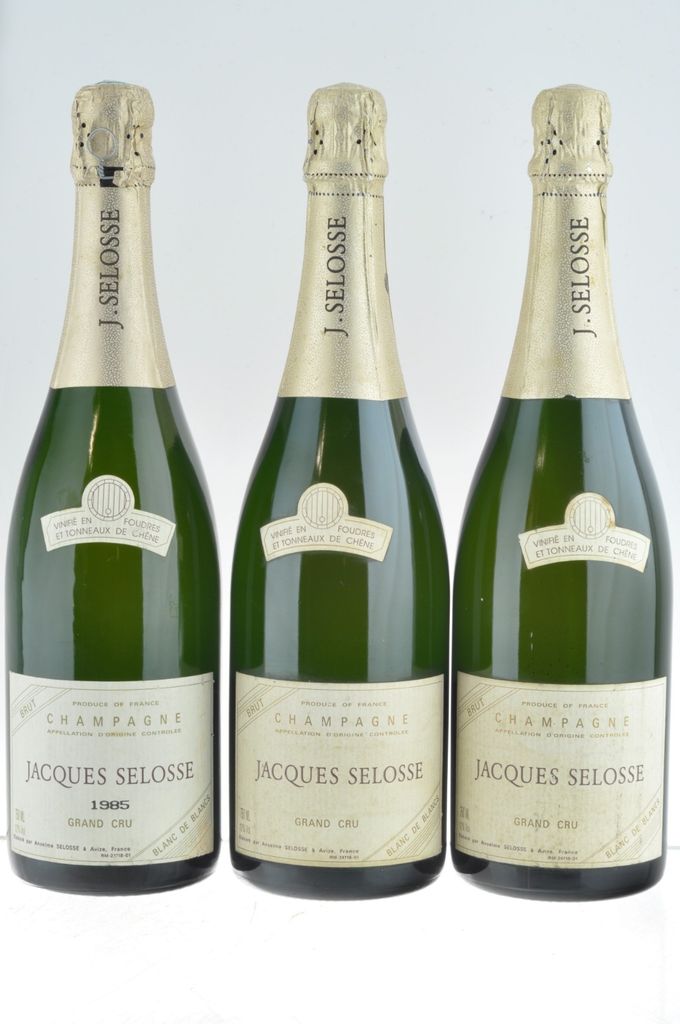
External search
Google (images)
Wine Advocate
Wine Spectator
Burghound
Wine-Searcher
Vintages
2013
2012
2011
2010
2009
2008
2007
2006
2005
2004
2003
2002
2001
1999
1998
1997
1996
1995
1993
1992
Show more
From this producer
Show all wines
All tasting notes
|
| Drinking Windows and Values |
| Drinking window: Drink between 1993 and 2007 (based on 39 user opinions) |
| Community Tasting History |
| Jacques Selosse Producer website
Wikipedia on Jacques Selosse
Jacques Selosse is a Champagne grower and producer based in the Avize region of Champagne.
The estate was founded by Jacques Selosse and his family in the 1950s, with the first vintage being bottled in 1960.
The current proprietor of this estate is Anselme Selosse who took over from his father Jacques in 1980. Anselme studied at the Lycée viticole de Beaune and was one of the first winemakers to apply the winemaking techniques of white Burgundy to Champagne. In 1994 Anselme was named best French Winemaker by Gault Millau.
Production
Jacques Selosse is a Grower Champagne, which means the grapes used to produce the wines are grown in vineyards owned by the winery rather than being purchased from other growers, as is the case in most Champagne production. The entire production is grown according to biodynamic principles and Anselme is considered a pioneer of biodynamics in Champagne. Selosse wines are fermented using oak barrels, in contrast to the majority of Champagne producers who use stainless steel tanks.
Two of the wines in Selosse's range, the Substance and the Contraste, are produced using a solera system, the same process used in Sherry production.
Selosse holds 37 acres (15 ha) of vines, predominantly Chardonnay with the remainder Pinot Noir.nAround 55,000 bottles are produced each vintage, dependent on conditions.
Wines
Initial is a blend of three vintages of Chardonnay grapes, aged for at least 2 years before disgorgement in a Brut style. The wine was initially called "Initiale" but dropped the "e" along the way. Before it was nameed Initial on the label, the label was identical but without the word Initial(e), therefore known as Jacques Selosse Grand Cru Blanc de Blancs Brut. Wines disgorged in 2006 do not have the Initial(e) addition, but wines disgorged in 2007 do.
Version Originale is also a blend of three vintages of Chardonnay, but it spends 42 months in bottle before disgorgment and has very little dosage resulting in an Extra Brut style.
Millésime is a single vintage Blanc de blancs made from the grapes of two vineyards in Avize, Le Mont de Cramant and Les Chantereines.
Substance is a Blanc de blancs from a single vineyard in Avize. This Champagne is made in a solera system with the base grapes for this wine coming from the 1986 vintage, the blend is topped up with more recent vintages each year.
Contraste is a Blanc de noirs, made from Pinot Noir grapes, coming from a single vineyard called La Côte Faron in the village of Aÿ. Like the Substance cuvée, this is made in a solera style. The base grapes in this wine are from the 1994 vintage.
Exquise is a Demi-Sec wine, with around 24g/l of dosage making this a semi-sweet style. Made entirely from Chardonnay grapes as a Blanc de blancs.
Rosé is produced using Chardonnay grapes from Selosse and Pinot Noir grapes from Egly-Ouriet in Ambonnay.Chardonnay The Chardonnay GrapeFrance Vins de France (Office National Interprofessionnel des Vins ) | Pages Vins, Directory of French Winegrowers | French Wine (Wikipedia)
Wine Scholar Guild vintage ratings
2018 vintage: "marked by a wet spring, a superb summer and a good harvest"
2019 vintage reports
2021: "From a general standpoint, whether for white, rosé or red wines, 2021 is a year marked by quality in the Rhône Valley Vineyards. Structured, elegant, fresh and fruity will be the main keywords for this new vintage."
2022 harvest: idealwine.info | wine-searcher.comChampagne Le Champagne (Le comité interprofessionnel du vin de Champagne) | Grandes Marques & Maisons de Champagne (Union des Maisons de Champagne)
France - When it comes to wine, France stands alone. No other country can beat it in terms of consistent quality and diversity. And while many of its Region, Bordeaux, Burgundy and Champagne most obviously, produce wine as rare, as sought-after and nearly as expensive as gold, there are just as many obscurities and values to be had from little known appellations throughout the country. To learn everything there is to know about French wine would take a lifetime. To understand and appreciate French wine, one only has to begin tasting them. Click for a list of bestselling items from all of France.
Sub-Region:
Champagne - The French region of Champagne (including the cities of Rheims, Épernay, and Aÿ) was the first region in the world to make sparkling wine in any quantity. Today, the name of the region is synonymous with the finest of all sparkling wines, and wine-making traditions of Champagne have become role models for sparkling wine producers, worldwide. Surprisingly, the region of Champagne is now responsible for only one bottle in 12 of all sparkling wine produced. Styles of champagne range in sweetness ranging from an extra brut or brut 0, to the basic brut to demi sec to doux; some houses produce single vintage champagnes and others produce non-vintage (or incorporate wines/grapes of multiple vintages), often to preserve a specific taste; combinations of grape varietals; and colors, including a rosé. There are several sub-appellations, including the Valley of the Marnes river running from Épernay west, Massif de Saint-Thierry north and west of Rheims, Valley of the Ardre, the Mountains of Rheims (between Rheims and Épernay), Côte des Blancs, Côte de Sézanne, and Côte des Bar in the South. Champagne wine only uses three grape varietals (cépages): Chardonnay, Pinot Noir, and Pinot Meunier.Champagne Grand CruChampagne |
|




